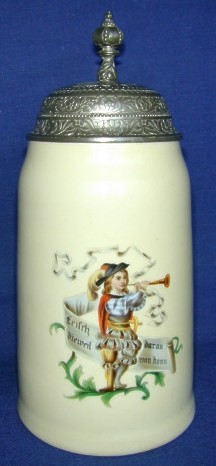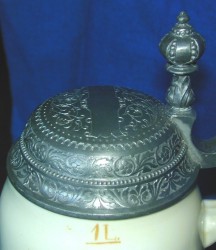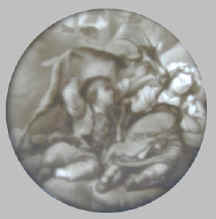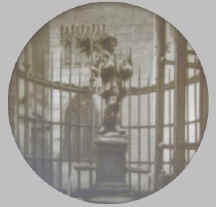 ~ Porcelain Steins with Lithophanes ~
~ Porcelain Steins with Lithophanes ~
by Walt Vogdes
|
Stein Collectors International |
|
|
|
|



 |
The illustration to the right shows
a nice 1-liter porcelain stein which was produced around 1900. The creamy,
glass-like body is decorated with a transfer scene in the Historismus style - a
page stands upon a foliate support while blowing his trumpet to command
attention. The pewter lid is nicely engraved, and sports a thumblift evocative
of earlier tastes. Like many porcelain steins, this one contains a lithophane,
or "picture", in its base. So while we look at the stein, we will also
discuss lithophanes and how they are made.
Because lithophanes are dependent upon the translucent nature of
porcelain, they are found exclusively in porcelain steins. When collectors first
discover one of these Victorian-era treasures hiding in the bottom of a stein,
they are understandably puzzled about it. How are such subtly beautiful images
formed, with no apparent use of paint or ink? Mr. Laurel Blair, founder and
curator of the Blair
Museum of Lithophanes, describes lithophanes as "basically a porcelain
transparency which when held before a light creates a three-dimensional image.
The image is obtained from the relative thickness of the porcelain. The tones of
the thinner area are lighter, while the thicker the porcelain, the darker the
picture.. The lighting brings out the soft variations of shadings and coloring
of the clay."
How do you spell it, really? Based upon the definition and derivation given
in Mirriam-Webster, the correct spelling is lithophane.
Both of the lithophanes shown in this article are larger than most (and in
my opinion, nicer than average, as well). The first, which is from the featured
stein, portrays a young farmgirl napping, while her goat gives her a nuzzle, or
perhaps is getting ready to eat her cap! The second is from the Nürnberg
Trichter (funnel) character stein. In this scene we see the statue of the
Gooseman of Nürnberg, which still greets tourists in a small square in
Nürnberg today.
The process of making a lithophane began with the carving of the image in
beeswax. Using a light source behind the wax to highlight the details, the
artists used fine steel and ivory tools to create the desired image. Thicker
areas remained dark, while deeply carved areas were lighter, allowing the artist
to create images of surprising detail. A plaster mold was made from the beeswax
image, and this mold was then used for forming the porcelain lithophane disks to
be inserted into the base of a porcelain stein. The same wax could be used to
make many molds, with details being sharpened if they became worn or distorted.
The stein bodies to receive these lithophanes were made as open cylinders.
It was a simple task for the finisher to join the lithophane to the body while
both pieces were still "green", and they fused together when fired.
Many lithophanes are specifically designed to complement the design or theme
of the stein. Among the most well known examples are two lithophanes found in
the bottom of the L.A.W. (League of American Wheelmen) character stein.
Fittingly, these scenes are of bicycle riders. Lithophanes commonly depict
soldiers and their girlfriends, monks, the Hofbrauhaus in Munich, the statue of
Bavaria, or tavern scenes. However, the "nude woman" lithophanes which
we see frequently were made following World War II.
One word of caution to collectors. Lithophanes, because they must be made
thin enough for the light to pass through, are inherently vulnerable to damage.
Many have been cracked or broken by their owner unthinkingly dropping a few
coins or a set of keys into the stein for safe-keeping. Ouch!
|
All rights reserved. |